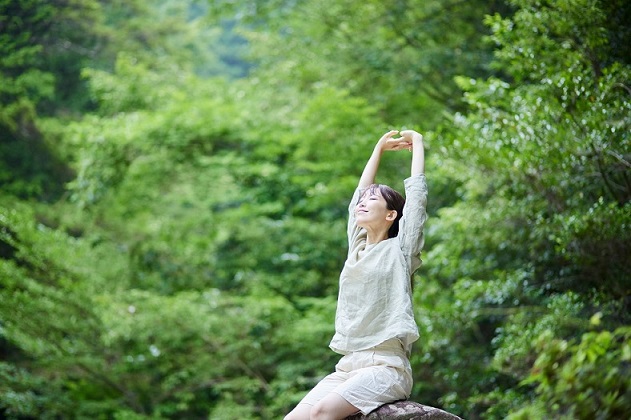In the heart of Japan’s cultural identity lies a tradition that transcends the superficial aspects of modern living, inviting people to reconnect with nature on a profound level. “Shinrin-yoku,” or forest bathing, is a practice deeply rooted in Japanese culture that has gained international recognition for its therapeutic benefits and its ability to foster a harmonious relationship between individuals and the natural world.

The Essence of Shinrin-Yoku: A Healing Tradition
Shinrin-yoku, a term coined in the 1980s by the Japanese Ministry of Agriculture, Forestry, and Fisheries, goes beyond the mere act of walking in the woods. It encourages individuals to engage all their senses while immersing themselves in nature, experiencing the sights, sounds, smells, textures, and even tastes of the forest. The practice aims to facilitate a mindful and meditative connection with the environment, promoting both mental and physical well-being.
Scientific Backing for Nature’s Healing Touch
Scientific studies have delved into the physiological and psychological benefits of shinrin-yoku, providing concrete evidence for what practitioners have intuitively known for centuries. Exposure to phytoncides, natural compounds released by trees, has been linked to a boost in the immune system, lower cortisol levels (associated with stress), and improved mood.
Additionally, the practice has been shown to reduce blood pressure, heart rate, and sympathetic nerve activity, contributing to an overall sense of calm and relaxation. With these scientifically proven benefits,
Designated Forest Therapy Trails in Japan
Japan has embraced shinrin-yoku as a cultural cornerstone, evident in the establishment of designated forest therapy trails across the country. These trails, carefully selected for their natural beauty and tranquillity, provide the perfect setting for individuals to engage in the practice.
One such trail is the Kumano Kodo, a historic pilgrimage route in Wakayama Prefecture. Here, amidst towering cedar trees and the rustling sounds of leaves, visitors can experience the profound serenity that has drawn pilgrims for centuries. The Arashiyama Bamboo Grove in Kyoto and the dense forests surrounding Mount Fuji are other popular destinations where one can partake in this restorative practice.
The Ritual of Shinrin-Yoku: A Journey of Mindfulness
Engaging in shinrin-yoku is not a rushed endeavour; it’s a slow, deliberate journey that invites participants to be fully present in each moment. As practitioners walk through the forest, they’re encouraged to observe the play of light through the leaves, feel the texture of the soil beneath their feet, and inhale the crisp scent of the forest air.
Meditative pauses are encouraged, allowing individuals to simply be in nature without the distractions of modern life. The ritual encourages mindfulness, a state of non-judgmental awareness of the present moment, fostering a deep connection with both inner and outer landscapes.
Shinrin-Yoku Beyond Borders: A Global Movement
While deeply rooted in Japanese culture, shinrin-yoku has transcended national boundaries, evolving into a global movement for nature therapy. Countries around the world have adopted the practice, recognizing the universal need for a holistic approach to well-being that incorporates nature.
Organizations and practitioners in various countries now offer guided forest bathing experiences, adapting the principles of shinrin-yoku to local landscapes. This cross-cultural exchange not only broadens the reach of this ancient practice but also highlights the shared human desire for a harmonious connection with nature.
Embracing Shinrin-Yoku in Everyday Life
In a world dominated by technology and urbanization, the principles of shinrin-yoku offer a beacon of hope for those seeking respite from the stresses of modern living. While designated forest therapy trails provide an immersive experience, individuals can also integrate elements of shinrin-yoku into their daily lives.
Simple practices such as spending time in a nearby park, cultivating indoor plants, or even taking a mindful stroll through a green space can contribute to the sense of well-being associated with forest bathing. The key is to approach these activities with intentionality, allowing nature to become a source of renewal and rejuvenation.
Conclusion
Shinrin-yoku stands as a testament to the enduring wisdom of traditional practices in fostering holistic well-being. As the world grapples with the challenges of a fast-paced and often stressful existence, the Japanese art of forest bathing offers a prescription for modern living—a return to nature’s embrace.
In the quiet rustle of leaves and the gentle murmur of streams, individuals find not only a reprieve from the cacophony of daily life but also a pathway to a deeper connection with themselves and the world around them. Shinrin-yoku, with its roots in ancient Japan, beckons us to slow down, breathe, and rediscover the healing power of nature—one mindful step at a time.










